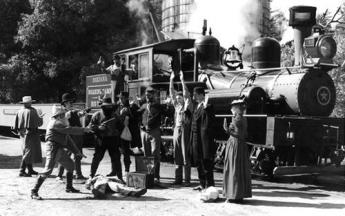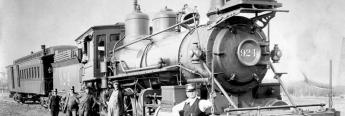Related Topics
Franklin Inn Club
Hidden in a back alley near the theaters, this little club is the center of the City's literary circle. It enjoys outstanding food in surroundings which suggest Samuel Johnson's club in London.
Railroad Town
 It's generally agreed, railroads failed to adjust their fixed capacity to changing demands. It's less certain Philadelphia was pulled down by that collapsing rail system.
It's generally agreed, railroads failed to adjust their fixed capacity to changing demands. It's less certain Philadelphia was pulled down by that collapsing rail system.
Federalism Slowly Conquers the States
Thirteen sovereign colonies voluntarily combined their power for the common good. But for two hundred years, the new federal government kept taking more power for itself.
RR Monopoly Self-Destructs

|
| Train Robbery |
A strange part of capitalism is that no company seems to last forever; seventy-five years is a long life for corporations. For this puzzle, partial insight emerges from American railroad history. After overcoming their novelty and growth pains, railroads soon had to confront the accusation their great size was itself a problem, unbalancing the playing field. Too big? Management resists that argument. Getting bigger was always good, especially when dealing with foreign competitors. A vital public treasure? Needing railroads doesn't create ownership rights, building them does. Railroad founders discovered a public need and served it; but the public replied it was their need and so it was their railroad, only temporarily in the hands of managers. Nothing useful was going to come of this faux debate, which structured itself in the 19th Century to reach equilibrium, not agreement. There is some reason to hope the ending of the Cold War a century later may have established more permanent understandings, but even those remain hostage to future history. By 1970 history seemed to be making quite the opposite verdict; at least eight major Northeastern railroads collapsed into helpless bankruptcy. Management blamed the senseless labor union work rules. The unions blamed incompetent management. As is usually the case, there's one lesson here for investors and quite a different one for reformers. All of the debaters need to reflect that possibly the collapse of the railroads was caused by attempting to create institutions which were bigger than they would need to be, fifty years later. Unless a way is provided for them to shrink, some form of shark will eventually eat them alive.
I am greatly indebted to a senior partner of one of Philadelphia's great law firms for insight into the decline of the railroad industry in Philadelphia, which took place during thirteen years of his active law practice on behalf of one of the bankrupt railroads. The insights are his, the opinions are mine.

|
| Interstate Commerce Commission Act of 1887 |
A railroad is inherently a monopoly. At first, that isn't obvious, as the railroads snake around to service potential customers. But it soon becomes apparent that it is generally easier to move a factory to an established rail head than to move an established railroad to the factory. Customers who doubt this soon find themselves less competitive than the competitors who recognize facts and respond to them. The location of rivers and raw materials make a difference, quite often enough to move the railroad; but when the railroad moves, it is only a matter of time before the mighty factory has to consider doing the same. That process tends to force everybody to greater efficiency, but it inconveniences many people, who appeal to their unions, who appeal to their politicians. This is a short summary of the origins of the Interstate Commerce Commission Act of 1887, which set the pattern for most later regulation of interstate commerce. The ICC Act, regulating and constraining the activities of railroads, was made law only a decade or so after the transcontinental railroads came into being. Since this had previously been an era of notoriously brutal clashes between the Reading Railroad and the Mollie Maguires, the entire regulatory process has been conducted like a cartoon of that remorseless struggle between one particularly fabled Irish Railroad President and one equally fabled Irish Railroad Union of song and story. The ultimately tragic end of the railroads was declared official by the Railroad Reorganization Act of 1973, which consolidated the freight business into a government-owned company called Conrail. For thirty years before the final demise, just about every president of just about every railroad -- was a lawyer. Others could run the engineering and the finance; in this business, survival itself depended on relations with government.
This description, while accurate in a way, misses a central point: what happens to an industry which was regulated and unionized as a monopoly -- when it develops competition and is no longer a monopoly? It badly needs to downsize, to reduce the overhead which comes from overcapacity, but the unions resist. Unless a way to reduce costs can be found, the company has put its foot on the down-escalator. The stock-market price declines as the profits erode, so borrowing becomes more expensive; the bond markets will sit in judgment on the outcome. A desperate management turns to technology and automation to improve productivity enough to compensate for the bulging overhead; but when improved technology makes even more employees redundant, the union balks and the increasingly obsolete regulations assist them. Competition from the highways and airlines is not going to relent, the unions feel they cannot or need not compromise, and sometimes will not permit productivity improvements. To the extent a company in that situation cannot reduce costs without reducing employment, it is very likely doomed. As the laws are now structured, the only escape is through bankruptcy. A nation's inability to stop this sort of corrosive cycle is one of the main reasons that typical American corporations seldom survive longer than a century. In the opinion of the constructive destruction theorists, that is a good thing for the nation. But it is a painful way to progress, and one does have to hope that a better way can someday be found.
For railroads, the main destructive force of federal regulation grew out of the rather rapid discovery that congressmen would demand a railroad in every state. While it may be hard to imagine a state that could survive the Industrial Revolution without at least one railroad, that wasn't necessarily imperative when new states were created and the land was cheap. And then if the Senate could require at least one railroad, it could also require stops and stations for every hamlet regardless of rational economics. And, if someone got struck by a passing train, it was hard to resist the demand for bridges over the tracks or tunnels under them. if some local developer wanted a grain elevator, the Senator was glad to make one mandatory. In their first fifty years when rail traffic was booming, railroad management was happy to comply. Everybody wanted to see the business get bigger. After 1920, however, the highways were starting to gain on the railroads; it was time to start being cautious. There began to be signs that requiring such excesses as five trainmen for every freight train, limiting the distance they could travel without a replacement, demanding "decent" wages, however, that might be defined, and a whole host of other costly impositions on the railroad -- were soon going to be things the railroads could no longer afford. In one way of looking at it, there was not even a need to be clairvoyant. Railroads were a century old in 1930; it was time to invest in something else. And by the way, it was probably time to look for another line of work.
It is common to hear that railroaders failed to notice they were in the transportation business, not merely the railroad business. That seems too easy to say; they were already in three distinct industries, freight, commuter rail, and long-distance rail. All three divisions were once profitable. The automobile first threatened the commuter rail lines, but then the airlines threatened the long-distance passenger business. And then the freight business was parasitized by the rest of the railroad industries. When too many people climbed into the lifeboat of profitable bulk cargo, it too collapsed from overload and nothing would rescue the whole rail industry except bankruptcy. It now needed suspension of government regulation and union contracts in order to merge, split, reorganize and introduce fifty years of accumulated but stalled productivity enhancements. Only bankruptcy would provide a way to keep the railroads limping along while drastic things were being done to them. Meanwhile, it was business as usual on the rhetoric battlefield; class warfare was never far from the bargaining table.
At this point in the analysis, my lawyer friend paused. In his opinion, the demise of the rail industry was not the main cause of the industrial decline of Philadelphia. The most important labor union struggle, in his opinion, resulted from the far more destructive behavior of the longshoremen's union, because ocean ships can quite easily move to another city where they are better treated; union intransigence very quickly destroys an international port. And to be fair, it isn't just unions that are tempted to treat foreigners badly. Almost all sovereign states have a history of taking what they can from non-citizens in their harbors; in America's case, there was a time when piracy was quite a respectable trade, conducted under the name of privateering. In the long run, exploiting foreign traders is self-defeating, but the temptation to exploit is always there. When intransigence gets out of hand, particularly when it is amplified by religious or class warfare, local poverty becomes quickly evident in maritime trade. Railroads just take a little longer to reach the same point.
Originally published: Thursday, June 17, 2010; most-recently modified: Wednesday, June 05, 2019